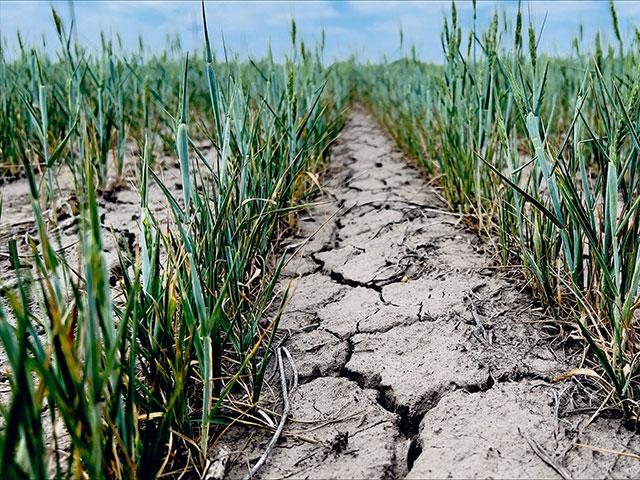Hard Winter Wheat Tour Day 1 Results
Day 1 of Winter Wheat Tour Shows Drought Stress
COLBY, Kan. (DTN) -- Gregory Jordan can remember the last major drought on the property he now farms south of Beloit, Kansas.
Barely.
He wasn't yet 3 years old and some of his very first memories, just snapshots, really, include a TV crew coming into their central Kansas farmhouse to interview his dad, Michael, about the year's failed crop. And he remembers standing on the front porch, rubber ducky in hand, when the rain finally came.
That was 1989, and it was the last time the Jordan family abandoned a wheat field. This year, they've already given up on several. One was evaluated by an insurance agent at less than 2 bushels to the acre. They're waiting on the official word for several more fields, perhaps up to nearly a third of this year's crop.
"This is the first time for me," Gregory said, now 35 years old and in his 12th year back on the farm.
The disappointing yield potential of the Jordan family plots was similar to much of the ground observed on Tuesday by the Wheat Quality Council's Hard Winter Wheat Tour, which began its three-day run across the state with 27 cars tripping from Manhattan, toward the northeastern part of the state, to Colby, toward the western half. DTN is participating in the tour.
The first day's total weighted average yield estimate was 29.8 bushels per acre (bpa), very close to Friday's USDA prediction for the state, which was at 29.0 bpa. That 29.8 average is down 25% from last year's Day 1 number, which sampled the same region of the state on identical routes.
"That's the lowest Day 1 average in a long time, a really long time," said Aaron Harries, vice president of research and operations with the Kansas Wheat Commission.
The farther east, the better the crop of the state's hard red winter wheat looked, but nowhere did it seem great. Fields closer to Manhattan were muddy from recent rains and didn't show drought stress as acutely as fields farther west. Even the "better" patches at times displayed freeze damage, however, at times hitting 5% to as much as 15% of the field. The stand was often patchy, and the heads that weren't partially damaged by frost were notably small, limiting potential.
P[L1] D[0x0] M[300x250] OOP[F] ADUNIT[] T[]
The toll of the drought was much more obvious farther west, where severely stunted wheat showed signs of struggle to grow high enough to be harvested even if a producer was so inclined.
"That has been an extremely short crop we've seen this year. We're seeing it head out at 8 or 10 inches. That's the first sign of extreme yield reductions," said Romulo Lollato, an associate professor of agronomy at Kansas State University. "A short crop like that will be extremely limited in yield. In a year with good yield potential, it isn't unusual to get into fields up to 30 inches tall. Just from a more practical standpoint, producers may be struggling with how short they can actually harvest a wheat crop."
Yield estimates were announced on Tuesday for neighboring states. Colorado, with 2.25 million planted acres, was estimated to have a yield of 32 bpa. The abandonment rate was projected to mirror last year's at 27%. That does make for a slight bump on the USDA projection figures released on Friday.
Nebraska was projected to harvest 29.6 bpa on 1.1 million acres with a 10% or less abandon rate.
The numbers are not expected to improve with Day 2 of the tour, which includes routes into western Kansas and south along, and in some cases over, the state line with Oklahoma.
Now, like the Jordan farm near Beloit, many Kansas farmers are asking hard -- and at times unfamiliar -- questions.
Is this crop worth bringing to harvest? When do you pull the trigger?
The Jordans stood behind the house where Gregory, 35 years old now, lives, in a 35-acre plot planted with grain they were hoping to harvest for seed.
The wheat was short and patchy. A yield estimate varied wildly from spot to spot, between below 10 bushels to the acre up to nearly 40 in a spot where the stand was thicker. There were a lot more 10-bushel areas than 40.
"It's supposed to be up here," Michael said, lowering his hand to the top of his knee.
His hand hovered 4 full inches above the heads of the wheat.
"And, he continued, gesturing to wide-open patches of dirt, "you're not supposed to be able to see the ground."
Agronomists and farmers said there haven't even been any real lessons. There's nothing to be learned about planting earlier or trusting this variety or that.
"It just hasn't rained," Gregory said. "The only lesson I've learned is about how to talk to the insurance adjuster."
The area has had about 16 inches in the last 12 months, but more than half that came in an exceptionally wet spell last May. Since then, it's been devastatingly dry.
He looked back across the field and asked another hard, new question.
"I wonder," Gregory said, "if we can get this whole patch on one truck?"
Joel Reichenberger can be reached at Joel.Reichenberger@dtn.com
Follow him on Twitter @JReichPF
(c) Copyright 2023 DTN, LLC. All rights reserved.






